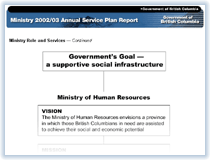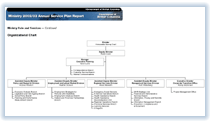 |
|
|
 |
 |
2002/03 Annual Service
Plan Report
Ministry of Human Resources |
 |
 |
Ministry Role and Services
Vision:
The Ministry of Human Resources envisions a province in which those
British Columbians in need are assisted to achieve their social
and economic potential.
Mission:
The Ministry of Human Resources provides services that move people
toward sustainable employment and assist individuals and families
in need.
Principles:
The Ministry of Human Resources' guiding principles directly reflect
and support the government's broader strategic plan and priorities.
The government's core values are: integrity, fiscal responsibility,
accountability, respect and choice.
The ministry's guiding principles are:
- Personal responsibility
- Active participation
- Citizen confidence
- Fairness and transparency
- Clear outcomes
- Accountability for results
During 2002/03, the Ministry of Human Resources operated 136 service
delivery offices in 63 communities throughout British Columbia.
Approximately 2,500 full-time ministry staff played a key role in
achieving the government's vision of a prosperous and just province,
whose citizens achieve their potential and have confidence in the
future.
The ministry encourages and enables those who are able to work
to find sustainable employment. For those who are not able to achieve
self-reliance through employment, the ministry provides continuous
assistance.
The ministry's approach is depicted in the
following diagram.

Ministry Operating Context
External factors
A number of factors external to the ministry contributed to a decline
in the need for income assistance during 2002/03:
- The B.C. economy produced approximately 78,000 new jobs in 2002,
with a further 25,000 new jobs created during the first quarter
of 2003. New jobs, and the movement of workers in the labour market
that they create, account for over 500,000 vacancies in B.C. during
a typical year.
- In 2002/03, the provincial unemployment rate fell by one per
cent. Each one per cent change in the B.C. unemployment rate affects
ministry expenditures by approximately $12 million annually.
- Average weekly wages in B.C. rose by 2.8 per cent in 2002/03;
which meant that people needed fewer hours of work to achieve
independence from income assistance.
- Continuing increases in the Canada Child Tax Benefit raised
some family incomes to the point where fewer families needed income
assistance.
Two external trends could contribute to increased demand for income
assistance in the future:
- The province's population is projected to grow by a little over
one per cent per year from 2003 to 2005.
- The proportion of persons with disabilities is increasing relative
to the total population. Persons with disabilities are more likely
to need income assistance than those without disabilities.
Internal factors
A number of internal factors also contributed to the ministry's
ability to achieve its goals and objectives:
- In 2002/03, the ministry underwent a significant cultural shift
to support the implementation of the BC Employment and Assistance
program (BCEA).
- The transition to BCEA required that field and headquarters
staff be trained and new tools be developed and implemented. To
support staff in the implementation of BCEA, an electronic field
guide was developed, as was a web-based reference tool. Learning
Services introduced a course library in January of 2002 that included
500 course titles in the subject areas of leadership, team building,
communications, call centres, personal development, project management,
customer focus, financial services, and human resources. These
courses are available to staff 24 hours a day, seven days a week
via the internet through the ministry's E-Learning Café.
- A series of web-based services available to the public were
introduced, making it easier for people to get information on
their own. The ministry also provided some services through telephone
service centres and automated telephone inquiry systems that make
services accessible, even in more remote areas of the province.
E-learning modules were written to introduce the legislative,
policy and procedural changes resulting from the proclamation
of the new legislation.
- The organization adopted a project management approach to designing,
developing and implementing complex policy and legislative changes.
Project teams were established across all ministry divisions to
make use of the broad range of expertise available throughout
the ministry and lead the implementation of new programs and policies.
- Accountability agreements were established for each region,
and new Employee Planning and Development Plans were introduced
to support an environment of professional development and ongoing
learning.
Core Business Areas
In 2002/03, the Ministry of Human Resources redefined income assistance
in British Columbia, implementing the BC Employment and Assistance
(BCEA) program. BCEA emphasizes self-reliance and personal responsibility,
and reduces long-term dependence on income assistance for those
who can work. For those unable to work because of a disability or
persistent multiple barriers to employment, BCEA offers assistance.
It also provides supports such as emergency shelter and health-related
services to those most in need.
BCEA is guided by two pieces of legislation: the Employment
and Assistance Act; and, the Employment and Assistance for
Persons with Disabilities Act. Both acts came into force in
September 2002.
The ministry delivered BC Employment and Assistance programs and
services in 2002/03 through five core business areas, each of which
was directly tied to the ministry's vision, mission and goals:
1. Employment Programs assisted clients to find and maintain
employment, including programs that supported persons with disabilities.
Employment and Assistance applications and employment plans were
completed by clients as a condition of eligibility. Individualized
employment plans may include referral to directed job search, job
placement programs and/or specific training for employment.
2. Temporary Assistance was available to eligible individuals
who were capable of financial independence through employment. Some
persons with disabilities were eligible to receive temporary assistance
while seeking work. Those unable to work because of a short-term
medical condition, because they were a single parent caring for
a young child, or because they were caring for a disabled family
member, could be temporarily excused from seeking employment.
3. Continuous Assistance was available to eligible individuals
who were not expected to gain independence through employment. This
included individuals with disabilities and those with persistent
multiple barriers to employment.
4. Supplementary Assistance provided health assistance to
persons with disabilities and some clients temporarily excused from
work. Other programs and services included emergency social services,
child care subsidies, bus passes, hostels and emergency shelters,
travel assistance, and user fees for continuing care and for alcohol
and drug facilities.
5. Corporate Services and Service Delivery. This core business
area provided for executive direction and direct operating costs
of delivering BC Employment and Assistance for research and performance
measurement, employee services, financial services, information
technology and information management.
Organizational Chart

Update on New Era Commitments
In a June 25, 2001 letter to the Honourable Murray Coell, Minister
of Human Resources, Premier Gordon Campbell identified three key
projects for the ministry:
1. Continue to streamline regional service delivery to clients
of income assistance.
2. Implement training and support programs to assist income assistance
clients in returning to the workforce.
3. With the Administrative Justice Project, develop a single internal
appeal process.
1. Streamlining regional service delivery
A long-term Electronic Service Delivery (ESD) initiative was developed
as part of this project. Over time, the ESD initiative will allow
staff to spend more time serving clients, improve public access
to ministry information, and improve the ministry's capacity to
meet its goals. During 2002/03, the ministry expanded its use of
information technology to deliver services, including an income
assistance estimator for people to assess their eligibility for
income assistance, a child care subsidy estimator for parents to
assess their eligibility for a subsidy, and a web-based orientation
for clients.
2. Implementing training and support programs to assist income
assistance clients in returning to the workforce
Four new programs began operation in 2002/03 to assist income assistance
clients in returning to the workforce:
- The Employment Program for Persons with Disabilities
was announced in April 2002. It provided a range of specialized
services to support persons with disabilities to take on voluntary
employment or employment-related activities. The program included
employment planning and pre-employment and employment services.
It provided supports for persons with disabilities in the workplace.
Clients who were not seeking independence through employment were
supported to work part-time or participate in volunteer activities
in their communities. The program is expected to be fully implemented
by July 2003.
- The Job Placement Program was implemented on July 1,
2002, following successful completion of a pilot project (the
Jobs Partnership Program Pilot). In partnership with contracted
agencies, the program provided a range of services that included
assessing clients' job-readiness, supporting client's to find
employment, monitoring clients' progress in the workplace and
providing support to employers. In its first nine months of operation,
the program placed 6,620 clients in employment.
- The Training for Jobs Program Pilot was implemented on
December 1, 2002. It provided short-term, integrated training
to enable clients — especially those who face barriers to
employment, and those who had not been successful in finding employment
with the assistance of other ministry programs – to enter
or return to sustainable employment as quickly as possible. Contracted
service providers worked with clients to identify their training
needs, provide skill-specific training, place clients in employment
and support them to sustain that employment over a period of 18
months.
- The Confirmed Job Supplement Program was initiated in
November 2002 to assist clients who had found employment, but
were unable to start work because they did not have money for
an essential support, such as work clothing or transportation.
Through this service, the ministry removed immediate barriers
for clients who might not otherwise have been able to start employment
they had been offered. The supplement directly assisted clients
to become independent of income assistance.
3. Developing a streamlined appeal process
- The Employment and Assistance Appeal Tribunal was introduced
in September 2002. Developed in conjunction with the Administrative
Justice Project, the new tribunal provided a single, streamlined,
independent process for reviewing clients' appeals in an open,
fair and timely way. It replaced the previous multi-step appeal
process, under which appeals sometimes took as long as six months
to be concluded. With the new process, regional panels adjudicated
appeals in as little as two weeks much more quickly.
|
|



